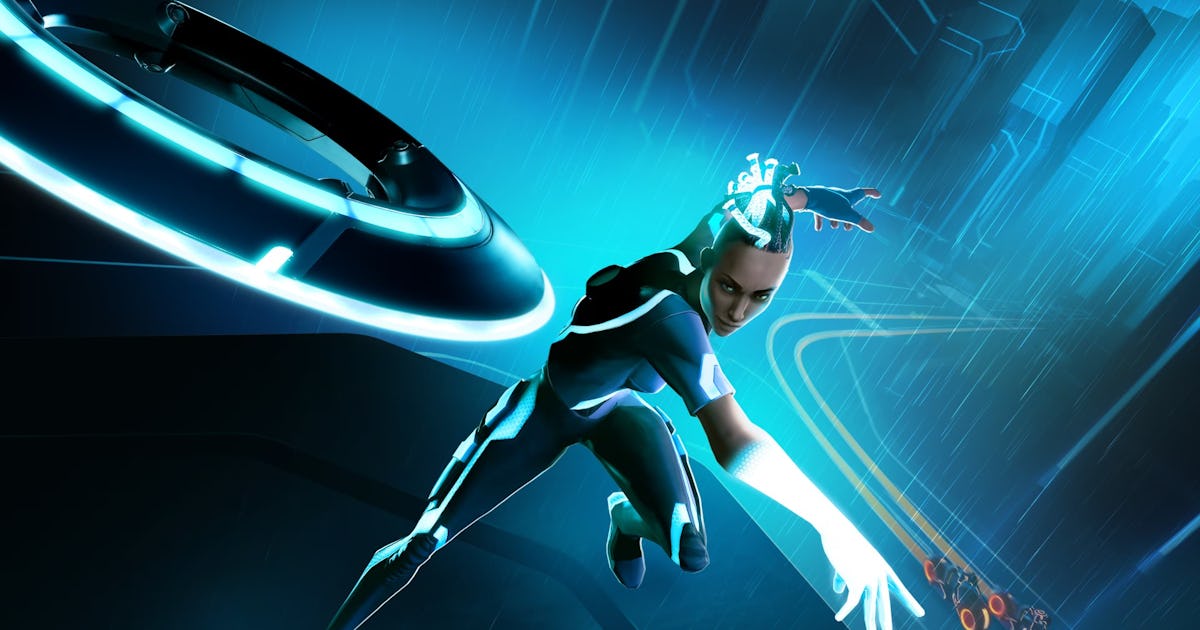Tron is one of the most iconic science-fiction properties in history, especially on the visual front. Its neon-infused aesthetic has become iconic and has inspired generations of artists and creators. While that visual style perfectly translates into video games like Tron: Catalyst, there’s an interesting metanarrative element present simply because of the series’ structure.
“We really wanted to lean in on that game aspect. This is, after all, a world created by a game designer,” says Tron: Catalyst writer and director Mike Bithell, “That meant building in fun to the environments, and making aggressive use of video game logic in the structure of the world. There are a lot of nods in the game to cliches and archetypes of games in general, and some fun riffs on licensed games in particular.”
Catalyst marks Bithell Games’ second foray into the neon-drenched streets of Tron, building on the story and world of the visual novel Tron: Identity for the studio’s first action-RPG. But it still embraces the cerebral, narrative-heavy style all of the studio’s games are known for. With the release of Catalyst, Inverse had the chance to chat with Bithell about returning to Tron, embracing the series’ iconic style, creating a dynamic time-loop mechanic, and more.
This interview has been edited for clarity and brevity.
While the Tron series has a pretty iconic visual design, there are some huge differences in aesthetic between the likes of the original, Legacy, Uprising, and more. With that in mind, how did you land on Tron: Catalyst’s visual style?
Bithell: Like most of our choices in the game, we took the history seriously. Our grid was founded by [a race of programs called] ISOs fleeing Clu, so we knew we were starting in an Uprising / Legacy era look. From there, we extrapolated with the evolution of that. I love the stylization of Uprising, but for our game, we felt a more grounded aesthetic would really shine. We pored over a lot of the concept art for Legacy, even referencing set blueprints to lock in on that style.
The time loop mechanic in Catalyst is interesting as it’s not just a narrative device, but can be used at any time. Where did the idea for it come from, and how hard was the looping mechanic to integrate into the game?
Bithell: It’s tricky, you do a lot of ‘what if the player looped at this very inconvenient moment’ design and writing. It was a part of the idea from very early on, as it gives us a bunch of space to play mechanically. We wanted to take full advantage of the digital world of Tron, time loops felt like a cool extension of that. It also fit thematically with our story of characters breaking the oppressive loops of their society.
Catalyst’s time travel is integrated directly as a gameplay mechanic, not simply a storytelling device — making it feel far more dynamic.
Bithell Games
Since you established the Arq Grid in Tron: Identity, how have you been able to build on that in Catalyst? How are the themes of these two games linked?
Bithell: It’s a great playground to explore a grid that’s older than any we’ve seen so far, giving us room to play with more complex and philosophically different factions. That’s a massive opportunity we took very seriously. We could also revisit characters established in Tron: Identity, see how they might have evolved or changed between games. That was exciting, as we began to build our own continuity.
After Tron: Identity, why did you decide that Catalyst would be an action game? Did you look at any previous Tron games for inspiration?
Bithell: We actually began thinking about Catalyst before we started Identity. We knew we wanted to make this bigger, more expansive game, but wanted to give players a path into it, storywise. Identity was always intended as an introduction, a staging ground for where we were heading. In terms of action, I think there have been some great Tron games before, from the old arcade machines through to 2.0 and Evolution. In all these cases, the designers have tried to tackle the exciting verbs of this world through the lens of their time. I enjoyed thinking about how to approach this with a 2020s mindset.
The setting in Identity and Catalyst is the Arq grid — which in lore is an Arq server created by Tron designer Kevin Flynn.
Bithell Games
One thing I’ve always wanted to ask about Tron: how do you convey the culture of the grid? It’s an electronic, almost ethereal, reality but it does have a culture. How do you portray that in Catalyst?
Bithell: Making this a world of ISOs goes a long way. We’re dealing with programs that have our intelligence and our emotional complexity. Arguably, they have potential even beyond us. That gave us space to tell a story about culture in a way that’s hard to do with simpler programs. Beyond that, it’s fun to think of the differences between a human and digital culture. Good fun sci-fi world-building stuff like: what do they trade? What do their family and romantic structures look like? Do they still believe in the users? So many fun threads to pull on.
Has working on Tron allowed you to approach the games from a meta perspective? What is it like working on games that take place within a video game world?
Bithell: We really wanted to lean in on that game aspect. This is, after all, a world created by a game designer. That meant building in fun to the environments, and making aggressive use of video game logic in the structure of the world. There are a lot of nods in the game to cliches and archetypes of games in general, and some fun riffs on licensed games in particular. If you grew up playing odd but interesting games based on movies, you’ll see some of that DNA in here.
Tron has a long history in video games, including being feature twice in the Kingdom Hearts franchise.
Square Enix
With Identity and now Catalyst, do you want to keep working on Tron? Are there any video game genres you think Tron would be a perfect fit for, that haven’t been done already?
Bithell: Hehe, I’ll keep my views on genre possibilities to myself, but I love this world, its characters, and its history. I’d love to tell more stories there if given the opportunity to do so. Ultimately, working on a franchise like Tron, you inherently understand that you’re building on the shoulders of others, and that in turn, others will follow you. I’m excited to see some of these ideas percolate.
As a fun aside, I have to ask, what did you think of the Tron sections of the Kingdom Hearts games? Did they influence you at all? And do you think Kingdom Hearts should return to Tron?
Bithell: Hah! I’ve not played much Kingdom Hearts, but I absolutely went back and checked out the Tron sections in preparation for this project. I thought they did an amazing job of capturing the worlds of the two movies. I’m up for as much Tron in the world as possible, so I hope they do go back.
Tron: Catalyst is available on PS5, Xbox Series X|S, Nintendo Switch, and PC.
Source link
Video Games,PlayStation,Xbox,nintendo,disney,xbox,gaming,tron,inverse-gaming-interviews,playstation,homepage,hp-latest,adex-no-bid



Average Rating